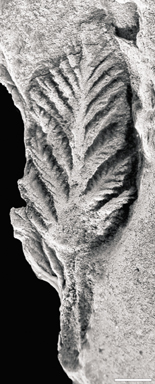 Paleontologists
have recently uncovered a goldmine of exceptionally well-preserved fossils in
Newfoundland, Canada. The 575- to 560-million-year-old fossils represent some
of the oldest and best-preserved remnants of soft-bodied organisms from the
end of the Precambrian.
Paleontologists
have recently uncovered a goldmine of exceptionally well-preserved fossils in
Newfoundland, Canada. The 575- to 560-million-year-old fossils represent some
of the oldest and best-preserved remnants of soft-bodied organisms from the
end of the Precambrian. New exquisitely preserved fossils from Newfoundland reveal features never previously seen on Ediacaran organisms. The longest fossil from the site is 7 centimeters, but Ediacaran organisms are known to have reached 2 meters in length. Image courtesy of Guy Narbonne.
Guy Narbonne, a paleontologist at Queen’s University in Kingston, Ontario, found the more than 100 animal-like fossils in a deep-water turbidite sequence near Spaniard’s Bay in northeastern Newfoundland, he reports in the July 15 Science online edition. The deep ocean environment in Spaniard’s Bay likely prevented storm waves or light from reaching the fossils, thus preserving features as small as 30 micrometers on the creatures, which varied from centimeters to meters in size.
These fossils, many of which vaguely resemble spindles and flattened feathers, are part of a distinctive fossil assemblage known as the Ediacaran biota: They represent the oldest large and complex organisms and ecosystems in Earth history, Narbonne says. Ediacaran fossils have been found in several sites around the world, but because the animals were soft-bodied creatures, the fossil evidence is scarce and little is known about them. And even where fossils were found, they had only been in one- and two-dimensional casts, at least until now.
“This is a fantastic discovery,” says Whitey Hagadorn, a paleontologist at Amherst College in Massachusetts, “most importantly because it demonstrates three-dimensional preservation of these organisms in Newfoundland.” The newly found specimens reveal never-before-seen internal features that provide insights in how life became large and complex, Narbonne says.

